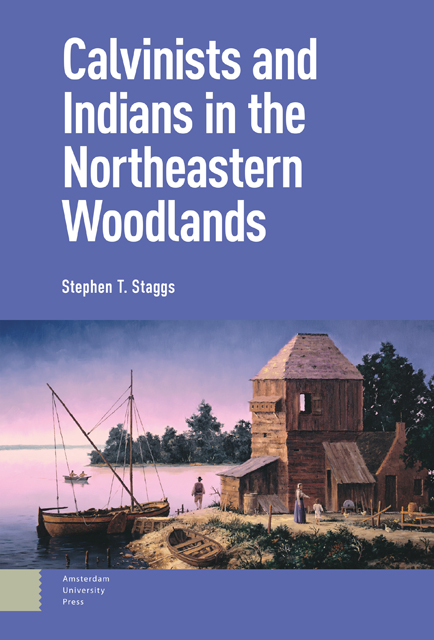Book contents
- Frontmatter
- Contents
- Acknowledgements
- Abbreviations
- List of Figures
- Notes on Usage
- Introduction
- 1 “Gentiles by Nature,” 1566–1626
- 2 “So That the Fullness of the Gentiles Might Gradually Come In,” 1627–1642
- 3 “A Church and Community among the Christians and the Blind Gentiles,” 1642–1652
- 4 “We, with God’s Help, Hope to Bring the Barbarous Tribes to Devotion,” 1652–1660
- 5 “Who Gave Jacob for a Spoil and Israel to the Robbers?” 1660–1664
- 6 “A Gentile Woman, Karanondo, … Now Called Lidia,” 1664–1750
- Conclusion
- Appendix A Dutch References to Indians: 1609–1664
- Appendix B Indian Baptisms, Professions of Faith, and Marriages in the Dutch Reformed Churches of New York: 1690–1750
- List of Archival Sources
- Bibliography
- Index
1 - “Gentiles by Nature,” 1566–1626
Published online by Cambridge University Press: 17 October 2023
- Frontmatter
- Contents
- Acknowledgements
- Abbreviations
- List of Figures
- Notes on Usage
- Introduction
- 1 “Gentiles by Nature,” 1566–1626
- 2 “So That the Fullness of the Gentiles Might Gradually Come In,” 1627–1642
- 3 “A Church and Community among the Christians and the Blind Gentiles,” 1642–1652
- 4 “We, with God’s Help, Hope to Bring the Barbarous Tribes to Devotion,” 1652–1660
- 5 “Who Gave Jacob for a Spoil and Israel to the Robbers?” 1660–1664
- 6 “A Gentile Woman, Karanondo, … Now Called Lidia,” 1664–1750
- Conclusion
- Appendix A Dutch References to Indians: 1609–1664
- Appendix B Indian Baptisms, Professions of Faith, and Marriages in the Dutch Reformed Churches of New York: 1690–1750
- List of Archival Sources
- Bibliography
- Index
Summary
Abstract
Chapter one examines the influences upon Johannes van Mecklenberg (Megapolensis). Born in 1603, Megapolensis came of age when Dutch Reformed theologians looked to the Bible to incorporate Native Americans into a Reformed worldview. In so doing, they characterized Indians as blind Gentiles to whom the Dutch were being called, by God, to present the gospel through the preaching of the Bible and the Christian conduct of colonists, which of course necessitated social interaction. This characterization ultimately informed the instructions given to those heading to New Netherland, raised expectations among the clergy and lay chaplains who served in the colony, and prefigured the reciprocal, intimate relationships that developed between Native Americans and New Netherlanders in the Northeastern Woodlands.
Keywords: Dutch Republic, Dutch Calvinism, New Netherland, Mohawk Indians, Mahican Indians, Native–Dutch Relations
Attitudes are feelings, often influenced by our beliefs, that predispose our reactions to objects, people, and events.
‒ David Myers, Psychology (2014)Alkmaar, 1566
In 1603 a baby boy was born into the Mecklenburg family in Koedijk, a small, rural village situated a little less than four miles north of the commercial town of Alkmaar in the Province of Holland. His parents named him Johannes. Johannes would come of age during a period of growing pains for the adolescent Republiek van der Zeven Verenigde Nederlanden (the Republic of the Seven United Low Countries commonly known as the Dutch Republic). Only thirty-seven years before the birth of Johannes, some of the inhabitants of Alkmaar participated in the beeldenstorm. This storm of iconoclasm initially broke out in Flanders in 1566 during the Feast of St. Lawrence. Following an open-air sermon in which an exile Calvinist preacher called an audience of around 2,000 to cleanse the church of idolatry, twenty evangelical activists entered the chapel of the monastery of St. Lawrence in Steenvoorde and smashed its sacred images and objects to smithereens. The storm rapidly moved north, reaching Alkmaar twenty-five days later when some activists entered the Great Church of St. Lawrence and began hurling holy images and relics to the ground. Although the activists spared the choir organ and artistic treasures that pre-dated Calvin's reformation, the damage had been done. Philip II, the devout Catholic lord of the seventeen provinces that comprised the Nederlanden (Low Countries) (see figure 3), could not abide such civil and religious dissent.
- Type
- Chapter
- Information
- Calvinists and Indians in the Northeastern Woodlands , pp. 27 - 60Publisher: Amsterdam University PressPrint publication year: 2023



